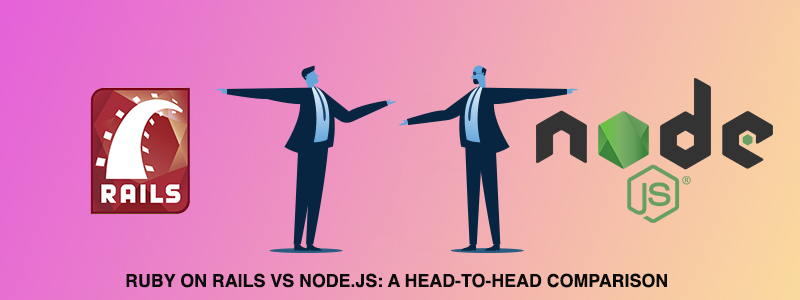When creating a backend and creating APIs and libraries, choosing a framework or language can be challenging. As of writing, Node.js and Ruby on Rails are the two most popular web development technologies.
It can be difficult to choose between them. Understanding the advantages and disadvantages of each of these technologies will help you make the right choice for your project. Our goal in this article is to provide you with an unbiased comparison between Node.js and Rails to assist you in making a decision.
What is the purpose of comparing these two technologies? While Ruby on Rails and Node.js may not seem directly analogous, plenty of users have asked the question online. We’ll discuss key features, key differences, and use cases of each technology in this article to help answer that question.
Node.js and Ruby on Rails: Background and Purpose
Node.js is not a language but a runtime environment for converting client-side code to server-side code. The Node program converts JavaScript into machine code that can be easily interpreted by the hardware. A Chrome V8 Engine is used to build the framework. The engine is one of the fastest out there, which contributes to the high conversion speed of runtime.
A website development framework based on Ruby on Rails. Among other things, rails are used to manage routines, internal logic, and data processing. In addition to its high speed and code efficiency, Ruby on Rails is known for its efficiency. The same task can be accomplished in Ruby with 5-10 lines instead of dozens in Java.
By examining their pros, cons, and use cases, we can compare Ruby on Rails and Node.js.
The companies that use Node.j’s
Performance and responsiveness are the main reasons why companies switch to Node.js. LinkedIn, Uber, Medium, New York Times, and Hapi are among the companies that use Node.js. Moving to Node.js can also mean switching to a microservice architecture for some companies.
As an example, Netflix used Node.js as its main backend tool to decentralize its web platform. PayPal’s development team did a similar thing to increase the app’s scalability and responsiveness. In prototyping and development, Node was used – and the team reports tremendous gains in efficiency and performance.
There is a problem with Node.js
The Node.js backend tool is by no means perfect. A number of server-side development features cannot be implemented in JavaScript because it is still primarily a front-end tool. Backend functionality isn’t suited to it by design. Because JS cannot run on servers, Node.js provides a somewhat limited experience as a result – here’s why.
Node.js processor consuming tasks
A single-thread language like Node.js processes one request at a time, unless you develop it as a series of events. Whenever we talk about fast operations, Node.js executes them quickly. Whenever we talk about time-consuming functions, Node does not treat them as events. If one operation is long-term, all the others will be blocked.
As a result, such an approach consumes a great deal of CPU power and dramatically reduces speed. As long as you don’t overload the app with consuming tasks, many Node.js advantages are applicable. Many of the positives of Node.js are lost when you cross that line.
The problem of security is difficult to solve
The Node.js ecosystem is known for its large size. Node.js developers benefit from open-source package management systems since they can reuse code, add-ons, and plugins.
Use ready components to save time and possibly improve code quality when using Node.js. It is important to understand the dangers posed by npm packages, however. In fact, the Node.js team has only recently begun scanning modules for security flaws. There are a number of npm packages, including tough-cookie, js.dom, and others, which have dependencies, vulnerabilities, and potential security risks.
What are the best places to use Ruby on Rails?
Backend frameworks for ウェブアプリケーション are based on Ruby on Rails. Scalability and efficiency make it a popular choice. The code required to write rich functionality is much shorter than for Java or Node.js.
Web application with full stack
Ruby on Rails is a highly structured framework for developing websites. Coding in Rails is governed by many rules. Model, View, Controller is the framework used by the framework. Views, controllers, and routes are required for an app to respond to a request. It may take some time to get started with an MVC framework, but the code is well-organized and easy to understand in the end. By the time you’re done, you’ll have an efficient, maintainable, and editable code.
Systems for managing content
Content management systems are not universally developed with Ruby on Rails. The most popular choice is still PHP development, but Ruby on Rails has gained a lot of traction in the field recently. Due to its high abstraction level, Ruby on Rails enables developers to write rich functionality quickly. The entire table and database can be mapped as a separate object. There are several lines of code you can use to refer to a significant chunk of functionality.
The prototyping process
In addition to letting you write code quickly, Ruby on Rails comes with built-in features that can be implemented in the ecosystem. The main priority when developing the minimally viable version of a product is operational efficiency and well-organized development processes, not ultimate speed and interface. With Ruby on Rails, developers can avoid writing code from scratch by using multiple command-line code builders. With open source libraries, more than half of functionality can be accommodated using this ready-to-use code.
Ruby on Rails: The Problem
There are many 開発者 who wonder why Ruby and Ruby on Rails aren’t more popular, given how productive the writing process is? It’s true that the language definitely wins in efficiency, but its performance reputation isn’t quite as impressive.
Speed of performance
Even experienced Ruby on Rails 開発者 acknowledge that the framework is slow when we compare it to Node.js. The framework’s speed has improved with each new version, but it remains slower than Node’s. In terms of performance, Ruby on Rails isn’t as good as Node.js when compared with Ruby.
Ineffective garbage collection
Languages that use garbage collection tend to be slower. A sudden spike in memory usage might cause developers to notice a drastic decrease in performance speed in their apps. A garbage collector will use more memory each time it iterates the application as it scales.
There is no static typing system
There is no static typing system in Ruby, which is one of the most noticeable drawbacks when comparing Ruby to Node.js. TypeScript allows integrated features that aren’t natively supported in JS. The variables used for these features are typical JavaScript variables. Neither native nor non-native components are treated differently by the language.
The Difference Between Node.js and Ruby on Rails
|
The criteria |
ルビー・オン・レール |
Node.js |
|
使用法 |
Development of backend web applications |
Development of backend web applications |
|
Language |
ルビー |
JavaScript |
|
Number of threads |
Multi-threaded |
Single-threaded |
|
長所 |
Easy development, Efficiency: code doesn’t repeat itself, Automated garbage collection, Readability |
High-performance speed, The possibility of using JS for the entire web project, Well-suited to microservice development, A top choice for REST API development |
|
短所 |
Slow speed, Memory allocation issues, No static typing |
npm security, Poor performance on CPU intensive tasks |
|
Use cases |
Minimum Viable Products, Prototypes, CMS development |
Real-time apps (chatrooms, games, collaboration services) |
結論
While Ruby and Node.js are both powerful for backend development, neither of them is perfect. The main selling point of Node.js is its ability to use JavaScript for the entire tech stack and its high-performance speed. Compared to Ruby on Rails, Node.js performs faster and has a greater capacity for real-time processing.
- Short-term operations can be handled efficiently by Node.js, and user interactions can be handled quickly. Its event-driven syntax and non-blocking processing make Node.js a highly responsive backend language.
- Despite being able to handle more than 10,000 concurrent requests, Node.js does not handle web-sockets well. As a result, Ruby cannot handle such a load – you will risk a server crash.





